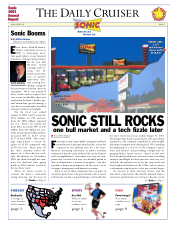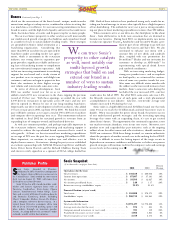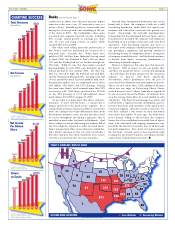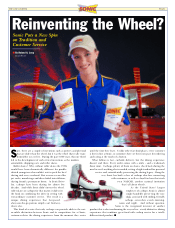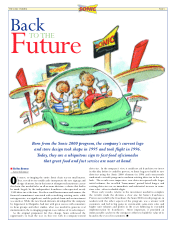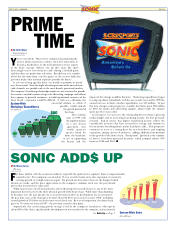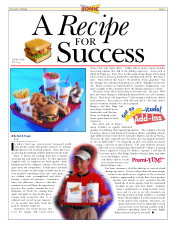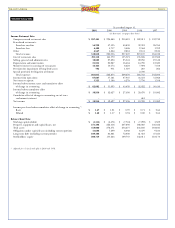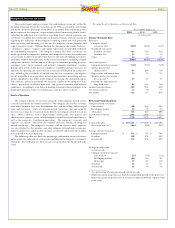Sonic 2001 Annual Report Download - page 6
Download and view the complete annual report
Please find page 6 of the 2001 Sonic annual report below. You can navigate through the pages in the report by either clicking on the pages listed below, or by using the keyword search tool below to find specific information within the annual report.
THE DAILY CRUISER PAGE 6
PRIME
TIME
■By Holly Wood
Entertainment
You’ve seen them. Those clever commercials promoting the
newest drink concoction at Sonic, the latest innovation in
Toaster®Sandwiches, or the truly distinctive service aspects
of the Sonic concept. (Where else do they skate like that?)
Increasingly you’ve seen them on cable, during a football game,
and elsewhere on prime-time television. But did you ever wonder
where the ads come from - not the agency or the creative folks, but
just what makes that national exposure possible for Sonic?
It was not so long ago that Sonic was unable to promote its brand
over the networks. Even late-night advertising on some of the more obscure
cable channels was possible only in the most densely penetrated markets.
The company’s franchising relationship simply was not structured to provide
the resources needed to mount a large-scale advertising campaign, and without
that exposure to potential customers - to build top-of-mind awareness of the
Sonic brand - expansion would be difficult. It truly was a dilemma, the
successful solution to which, if
possible, would unleash
the growth potential of
the chain.
That solution
came in 1994 with
the implementation
of a new license
agreement that
would generate
greater funds for
Sonic, the franchisor,
to use in supporting
the brand, and the
impact of this change would be dramatic. Marketing expenditures began
to ramp up almost immediately with the new royalty rates and by 1999 the
annual increase in Sonic’s media expenditures was $10 million. To put
this into a longer-term perspective, consider that Sonic spent $80 million
in 2001 for media and advertising support, almost triple the amount
spent just five years earlier.
In retrospect, it’s easy to see the relationship between Sonic’s growing
media budget and its increasing franchising income, for they go hand-
in-hand. And of course, that higher franchising income reflects the
considerable increases that have occurred in average unit volumes in
the meantime, benefiting Sonic and its franchisees alike. This prosperity
continues to serve as a strong draw for new franchisees and ongoing
expansion among current franchisees, adding additional momentum
to the growth of the Sonic chain. Need proof? Just look at the number
of Sonic’s franchisee-operated locations, which jumped almost 50%
between 1996 and 2001. ■
■By Macon Green
Business
For those familiar with the restaurant industry, especially the quick-service segment, Sonic is unquestionably
a growth story. Few companies can match its 15-year record of same-store sales expansion, its consistent
earnings growth, or its high return on equity. For growth-stock investors, these are the things of which
dreams are made, and the price appreciation in the company’s common stock over the past decade
proves that investors have taken note.
While many factors clearly have played a role in this long-term record of success, one of the more
important drivers has been the sheer physical growth of the Sonic chain. While more than doubling
its locations over the past decade, the real acceleration in drive-in development has occurred over
the past four years as the chain grew by more than 160 drive-ins in each year since 1998 - including
record growth of 191 drive-ins in the most recent fiscal year. By way of comparison, the Sonic chain
grew by 113 drive-ins in fiscal 1997 - the previous record to that point.
Importantly, this accelerating growth strategy is led by the company’s franchisees, who operate
about 80% of the chain, spearhead the development of new markets for the company, and account for
System-Wide
Marketing Expenditures
(In millions)
System-Wide Sales
(In millions)
SONIC ADD$ UP
See Adds Up on Page 7

